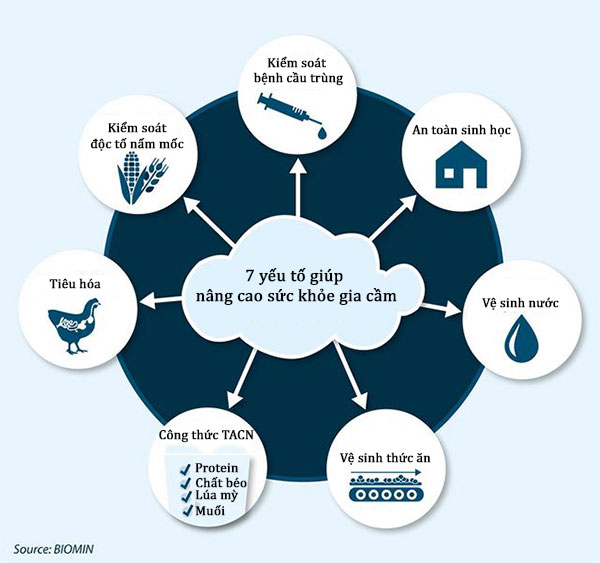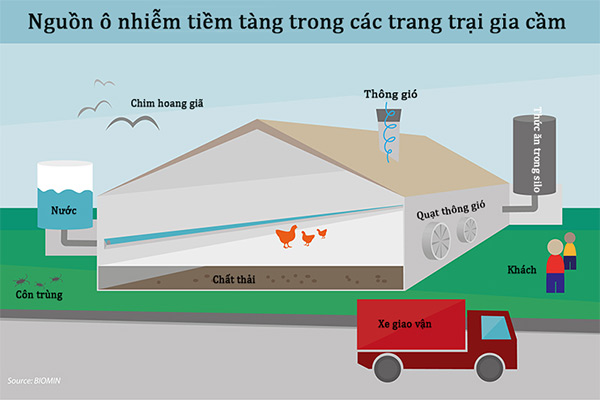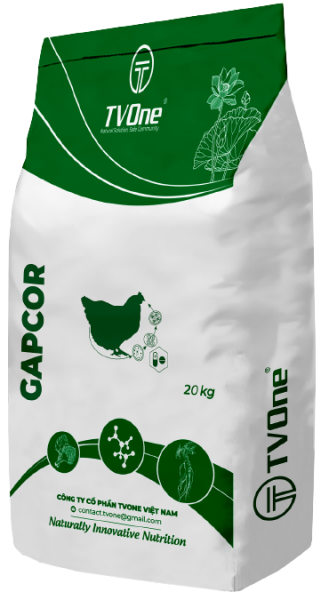Using antibiotics for prevention and growth promotion can help chickens increase their health and immunity against diseases. In the meantime, it can increase the antibiotic residues in food products, which makes consumers afraid and the cost of antibiotics is not small compared to the production cost. Therefore, all the large-scale chicken farms aim to provide the market with better quality products (meat or eggs) with low or no residual antibiotic content to meet the growing needs of consumers.
However, because of depending too much and too long on antibiotics, many poultry farms can not stop using antibiotics. If they stop, just for a short time, there will be a problem with the reduction of chickens’ health, high mortality rate, and decrease in meat quality The experts advise 7 factors that farmers need to focus on to keep chickens healthy but reduce the use of antibiotics.

Appropriate nutrition
In raw materials or through incomplete heat treatments, there can always be substances that have no nutritional effect, some of which are harmful to the body (e.g. non-starch polysaccharides in wheat, trypsin inhibitors in soybean meal, etc.). These substances can be limited by the strict quality control of raw materials or the use of specific enzymes to neutralise them. Proper nutrition can reduce the stress on the gastrointestinal tract of chickens, thus minimising the use of antibiotics in livestock production.
Clean food - no contamination.
While some feed ingredients have a higher risk of contamination than others, especially with salmonella, poor packaging and storage can affect any component, leading to contaminated feed. Several ways could prevent contamination, from controlling raw materials to hygiene in production and packaging. Heat treatment and pelleting can be considered to limit feed contamination. Some products used to solve this problem are also available on the market.
Waterer system
Water is one of the most critical nutrients to chickens, but farmers hardly notice this factor. The chickens' needed water is often doubled or tripled in their feed. In some developing countries, most farms will use water from wells that are usually contaminated. This can be one way that leads pathogens into the farm, especially Coliform bacteria. Thus, farmers need to manage the water sources, clean the water pipe system, and add acidifiers to maintain water pH, ensuring the chickens' health.
Digestibility of chickens
When the digestibility reduces, the nutrition is hard to go to the colon leading to the growth of pathogenic bacteria. This situation can cause some colon diseases like necrotic enteritis in chickens. Besides feed composition, chickens’ digestibility is also a concern to farmers. Thus, in addition to careful management, farmers can use products assisting chickens’ digestibility and limit the development of pathogens. The better animals absorb nutrients better, the less food for pathogens to develop so that animals can regulate the intestinal microbiome themselves.

Mycotoxins problem
Mycotoxins are present in all materials at different levels depending on the environment and management. Many experts indicate that deoxynivalenol (DON) and fumonisin B1 (FUM) are the most common mycotoxins contaminating feed and raw materials. DON and FUM are known to damage the gut through different mechanisms. Therefore, farmers should regularly monitor mycotoxin concentrations in raw materials and finished feed in livestock production. In addition, using an appropriate level of mycotoxin detoxification can also be an excellent way to help control any potential contamination.
Coccidiosis
In some countries, Coccidiostats ionophore is not allowed in chicken feed is the feed companies do not want to mix the antibiotics into their feed. In such cases, vaccination against coccidiosis is a knowledge that any poultry farmer should know and implement if necessary. Research has shown that using vaccines in combination with symbiotic products can enhance the anti-coccidial effect of the vaccine.
Gapcor has all-natural components, oregano essential and other plant extracts. Gapcor can help prevent coccidiosis in poultry, replacing VinaCoc, Han Coc or Sulfacoc. With a desire for no-antibiotics, no-vaccines, and no-chemical and organic agriculture, TVOne is proud to pioneer in the research and development of feed additives, ultimately from herbal material. We developed a supplementary product for the growth of chickens - Garpil - to optimise cost and increase productivity and quality - it has been used in many factories and farms in Vietnam.



